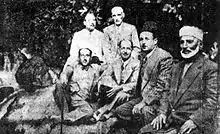Syrian nationalism
Syrian nationalism, also known as "Pan-Syrian nationalism", refers to the nationalism of the region of Syria, or the Fertile Crescent as a cultural or political entity known as "Greater Syria". It should not be confused with the Arab nationalism that is the official state doctrine of the Syrian Arab Republic's ruling Arab Socialist Ba'ath Party, nor should it be assumed that Syrian nationalism necessarily propagates the interests of modern-day Syria or its government. Rather, it predates the existence of the modern Syrian state (independent from French colonial rule in 1946), and refers to the loosely defined Levantine region of Syria, known in Arabic as Ash-Shām (Arabic: ٱلـشَّـام).[1]
History
Syrian nationalism arose as a modern school of thought in the late 19th century, in conjunction with the Nahda movement, then sweeping the Ottoman-ruled Arab world.
The first Syrian nationalist is considered to be Butrus al-Bustani, a Mount Lebanon-born convert from the Maronite Church to Protestantism, who started one of the region's first newspapers, Nafir Suria in Beirut in the aftermath of the Mount Lebanon civil war of 1860 and the massacre of Christians in Damascus in the same year.[2] Bustani, who was deeply opposed to all forms of sectarianism, said Ḥubb al-Waṭan min al-Īmān (Arabic: حُـبّ الْـوَطَـن مِـن الْإِیْـمَـان, "Love of the Homeland is a matter of Faith").
As early as 1870, when discerning the notion of fatherland from that of nation and applying the latter to Greater Syria, Francis Marrash would point to the role played by language, among other factors, in counterbalancing religious and sectarian differences, and thus, in defining national identity.[3] This distinction between fatherland and nation was also made by Hasan al-Marsafi in 1881.
After 1941, the prime minister of Iraq Nuri Pasha al-Said expressed his support for a Greater Syria country that includes Iraq, Syria, Lebanon, Palestine and Jordan.[4] Although this never happened.
Ideology
Syrian nationalism posited a common Syrian history and nationality, grouping all the different religious sects and variations in the area, as well as the region's mixture of different peoples. Thus, while not per se anti-Arab it opposed the Arab nationalist ideology and its pan-Arab underpinnings, that somewhat later was to grow all over the Arab world, not least in Syria itself.
It opposes any particular Arab claims to these areas, preferring an all-encompassing Syrian nationality; also, it is a generally secular movement, believing that a Syrian can have any religion indigenous to the area: Sunni or Shia Muslim, Christian or Jewish. This has attracted many Christians to it (as well as to the equally non-religious Arab nationalism), since the Christian churches form a religious minority in the Middle East, and often fear being dwarfed by Muslim majority populations.

Syrian nationalism often advocates a "Greater Syria", based on ancient concepts of the boundaries of the region then known as Syria (stretching from southern Turkey through Lebanon, Palestine into Jordan), but also including Cyprus, Iraq, Kuwait, the Ahvaz region of Iran, the Sinai Peninsula, and the Kilikian region of Turkey.[5][6] A modern-day political movement that advocates these borders, is the Syrian Social Nationalist Party (SSNP), founded in 1932 by Antun Saadeh. The present-day borders of the area are seen as artificial and illegitimate imperial divisions, imposed on the region by the Anglo-French Sykes–Picot Agreement and as well as the creation of Israel as an independent state. However, the SSNP accepted from an early stage that specific political and communal conditions in Lebanon meant that for the time being Lebanon would have to remain in existence as a separate state. In later years, and particularly since 1970, the main body of the party has also come to adopt a more nuanced position regarding Arab nationalism. It no longer openly proclaims that the Syrian people are non-Arabs, but rather regards Greater Syria as playing a vanguard role among the Arab peoples. Smaller factions which split from the party maintain a position inimical to Arab nationalism, however.
Role of Language
As the pan-Syrian ideology is based on a shared geographical culture, it is open to different opinions about the state of languages. While al-Bustani considered Standard Arabic an essential part of this identity, Saadeh considered Arabic to be one of the many languages of the Syrian people and instead believed that if a national language has to be used for shared communication and written culture, without losing everyone's other language, it has to be 'Syrianised' Arabic.[7]
The Syrian-Israeli conflict
SSNP considers the reason of losing territory to the 'foreign' Israelis is that many Syrians embraced pan-Arab views which lead to the dominance of Egypt and Saudi Arabia over the conflict, where they did not care about sacrificing what Syrians had for their agenda and personal benefits instead of limiting other non-Syrian Arabs to supporting Syrians' decisions. According to Antoun, this happened when the Syrians had a weak ideology that did not unite them.[8][9]
See also
References
- Kamal S. Salibi (2003). A House of Many Mansions: The History of Lebanon Reconsidered. I.B.Tauris. pp. 61–62. ISBN 978-1-86064-912-7.
To the Arabs, this same territory, which the Romans considered Arabian, formed part of what they called Bilad al-Sham, which was their own name for Syria. From the classical perspective however Syria, including Palestine, formed no more than the western fringes of what was reckoned to be Arabia between the first line of cities and the coast. Since there is no clear dividing line between what are called today the Syrian and Arabian deserts, which actually form one stretch of arid tableland, the classical concept of what actually constituted Syria had more to its credit geographically than the vaguer Arab concept of Syria as Bilad al-Sham. Under the Romans, there was actually a province of Syria, with its capital at Antioch, which carried the name of the territory. Otherwise, down the centuries, Syria like Arabia and Mesopotamia, was no more than a geographic expression. In Islamic times, the Arab geographers used the name arabicized as Suriyah, to denote one special region of Bilad al-Sham, which was the middle section of the valley of the Orontes river, in the vicinity of the towns of Homs and Hama. They also noted that it was an old name for the whole of Bilad al-Sham which had gone out of use. As a geographic expression, however, the name Syria survived in its original classical sense in Byzantine and Western European usage, and also in the Syriac literature of some of the Eastern Christian churches, from which it occasionally found its way into Christian Arabic usage. It was only in the nineteenth century that the use of the name was revived in its modern Arabic form, frequently as Suriyya rather than the older Suriyah, to denote the whole of Bilad al-Sham: first of all in the Christian Arabic literature of the period, and under the influence of Western Europe. By the end of that century it had already replaced the name of Bilad al-Sham even in Muslim Arabic usage.
- Tauber, Eliezer (1 February 2013). The Emergence of the Arab Movements. Routledge. ISBN 978-1-136-29301-6.
- Suleiman, p. 114.
- Encyclopedia of Arabic language and linguistics. Brill. p. 348, vol. 3. ISBN 9004144730.
- Sa'adeh, Antoun (2004). The Genesis of Nations. Beirut. Translated and Reprinted
- Ya'ari, Ehud. "Behind the Terror". The Atlantic.
- Encyclopedia of Arabic language and linguistics. Brill. p. 348, vol. 3. ISBN 9004144730.
- Hussein, Hashim. "Oh you deceived people by the fake pan-Arabism! We Syrians are one complete nation". www.ssnp.info. Retrieved 9 January 2019.
- Saadeh, Antoun. "Arabism has failed". www.ssnphoms.com. Retrieved 9 January 2019.
- Suleiman, Yasir (2003). The Arabic Language and National Identity: A Study in Ideology. Edinburgh University Press.


